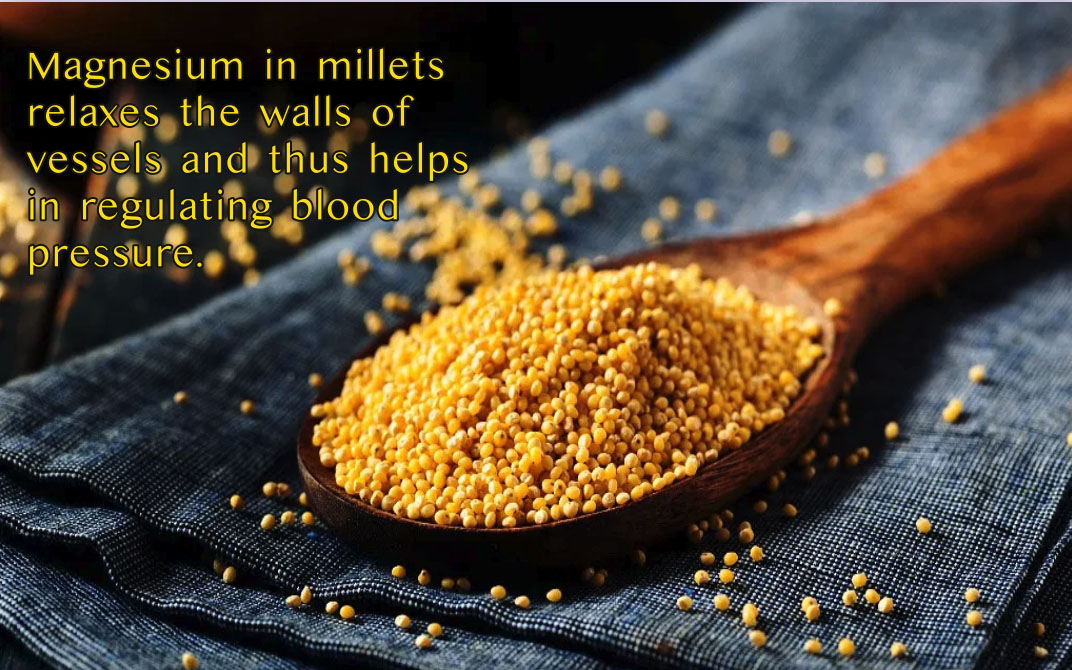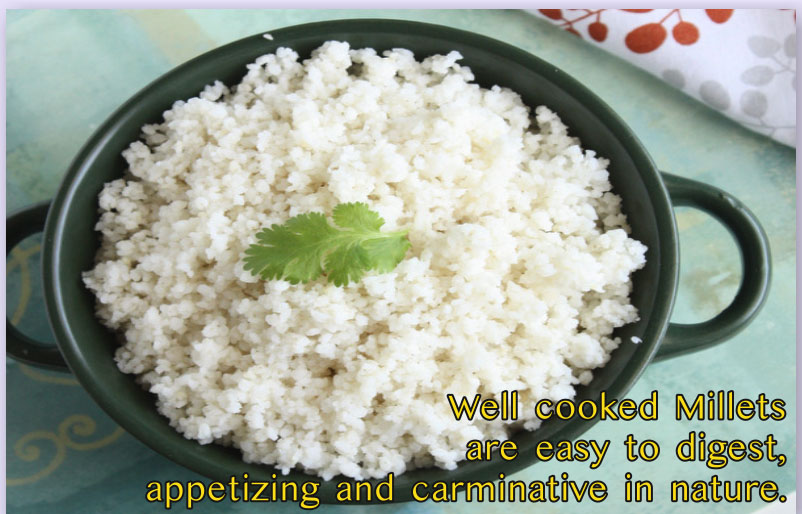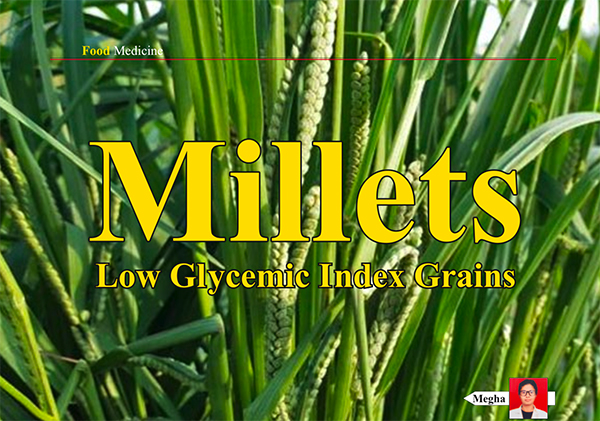The most popular Indian millet is Pearl millet called Bajra in hindi and the second most widely grown millet in India is Foxtail called Kangni. Millets are Gluten free & help in patients suffering from Gluten-sensitive enteropathy and very effective for wheat allergy patients. Millets are a vital part of a well balanced diet. They are low in calories and contain more fiber than wheat which helps to maintain satiety and thus aid in weight loss. Millet is a gluten free whole grain and the good source of fibre. It is having low glycemic index which has a positive effect in fight against diabetes.Millets are rich in iron and folic acid, thus help prevent anemia by supporting the formation of red blood cells and maintaining adequate hemoglobin level.
Millet is a cereal grain that belongs to poaceae family, commonly known as grass family. It is widely consumed in the developing countries throughout Africa & Asia. It is a small round whole grain grown in India & Nigeria. It is used for both human consumption & livestock as bird feed. It possesses high nutritional value and is rich in protein, vitamins, minerals and fiber. It is an alkaline food and balances pH of the body. It is cultivated in less fertile soil and requires less water and is resistant to pests and diseases. It is often referred to as poor people’s crop. In Ayurveda, millets belong to group of Trinadhanya Varga (group of grains produces by grass like plants). Millets are generally divided into two broad categories-

1. Naked Grain
This type of millet is devoid of hard, indigestible husk. These are Ragi, Jawar, Bajra. These millets do not required processing after harvest. They can simply be used after being cleaned. These are the major millet types which are largely cultivated and are quite popular because of easy use.
2. Husked Grain
Foxtail, Little millets and Kodo millets belong to this second type. These millets consist of an indigestible seed coat. The husk on them needs to be removed before consumption.
Millets are the good source of antioxidants. They improve digestive and respiratory functions, detoxify the body, boost the immunity and prevent degenerative diseases like parkinsonism, dementia and aging of skin. They are used to prepare beverages, breads, porridges and snacked foods .

HEALTH BENEFITS OF MILLETS
1. Rich in antioxidants
Millets are rich in phenolic compounds specially catachins and ferulic acid. These molecules act as anti-oxidants and protect the body from harmful oxidative stress. Studies show the properties of ferulic acid in millet as anti-inflammatory also.
2. Heart friendly
The magnesium and vitamin B3content in millets help in preventing the heart attack by reducing the level of bad cholesterol and maintaining the elasticity of the blood vessels. The hard vessels are responsible for causing heart diseases, high blood pressure and brain stroke .
3. Helps in Weight Loss
The caloric content of millets is incredibly low so they are great food for weight loss. At the same time they help maintain energy level throughout the day. They keep us satiated for long.
4. Gluten Free diet
Millets are Gluten free & help in patients suffering from Gluten-sensitive enteropathy and very effective for wheat allergy patients.
5. Anti Ulcer
Millets have anti-ulcer effect. They promote ulcer protection by decreasing ulcer index & TBARS values (Thio Barbituric Acid Reactive Substance)
6. Prevents Gall Stones
With plenty of insoluble fibres, Millets prevent gall stones by reducing intestinal transit time. They also reduce bile acid secretion which is known to be the cause of gall stone formation.
7. Healthy for bones
Foxtial variet of Millet has high calcium content which is very important for maintaining bone health. It has twice the amount of calcium when compared to the rice.
8. Regulates Blood Sugar
Millet is a gluten free whole grain and the good source of fibre. It is having low glycemic index which has a positive effect in fight against diabetes. It is a suitable dietary compound to combat the growing prevalence of diabetes all over the world. Magnesium in millets provides a benefit of improving insulin sensitivity.
9. Helps in Digestion
Millets help to eliminate problems like constipation, bloating & cramping by regulating digestive process. It also prevents more serious gastro intestinal conditions like cancers.
10. Eases Breathing
Researches suggest that high level of magnesium in millets can help eliminate respiratory issues in asthmatic patients.
11. Regulates Blood pressure
Magnesium in millets relaxes the muscles that lines the inside of arterial walls thus helps in regulating blood pressure.
12. Helps Sound Sleep
Tryptophan in millet raises the serotonin level in the body and helps to combat stress and can help to get peaceful sleep.
13. Healthy for Skin
Millets are rich in amino acids L-lysine and L-protein which help to form collagen in the body, a substances which tightens the skin tissue. Thus, eating millet fortifies collagen to improve skin elasticity & make it less prone to get wrinkled.
14. Improves Hemoglobin Level
Millets are rich in iron and folic acid, thus help prevent anemia by supporting the formation of red blood cells and maintaining adequate hemoglobin level.
Cooked Millets are light to digest
Well cooked Millets are easy to digest, appetizing and carminative in nature. When it is cooked, a mucilagenous substance rises on the top of millets which is having healing properties.
Conclusion
Whole millet and millet flour are naturally gluten free and a great alternative to rice and wheat for gluten sensitive people. To get the maximum health benefits of this cereal, we should incorporate it into our diet.
Megha
Internee,
Dayanand Ayurvedic College,
Mahatma Hans Raj Marg, Jalandhar.







 Dec 2024
Dec 2024
 May 2024
May 2024
 September 2022
September 2022
 April 2022
April 2022
 October 2020
October 2020
 Jan 2020
Jan 2020
 June 2019
June 2019
 January-February 2019
January-February 2019
 Augest-September
Augest-September
 April 2018
April 2018
 November 2017
November 2017
 June 2017
June 2017
 November 2016
November 2016
 September 2015
September 2015
 March 2015
March 2015
 July 2014
July 2014
 January 2014
January 2014
 July2013
July2013
 March 2013
March 2013
 May 2012
May 2012
 May 2011
May 2011
 Sep 2010
Sep 2010
 Jun 2010
Jun 2010
 Feb 2010
Feb 2010
 December 2009
December 2009
 August 2009
August 2009
 June 2009
June 2009
 Feb 2009
Feb 2009
 December 2008
December 2008
 October 2008
October 2008
 March 2008
March 2008
 July 2008
July 2008
 May 2008
May 2008